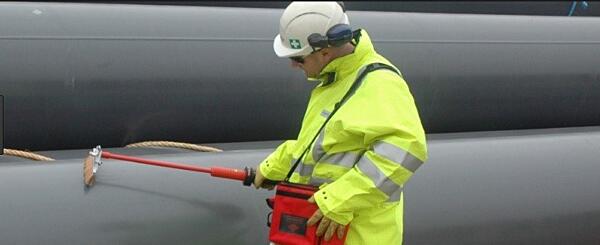Holiday Testing of Coatings Applied Over HDG
Is holiday testing used to inspect Duplex Systems?
Holiday testing is a non-destructive inspection method used to detect unacceptable discontinuities (voids, pinholes, fisheyes, cratering, nicks, and sometimes weaknesses) in a non-conductive coating film which are not easily visible. Though not all structures or industries utilize holiday detectors, general types of holiday detectors include:
- Low-voltage DC
- High-voltage DC
- High-voltage pulsed DC
- High-voltage AC

A holiday detector works by applying concepts of electrical conductivity. A non-conductive coating applied over a metallic substrate inhibits the flow of electricity between the detector probe and the base metal. Voids in the coating will allow exposed metal to complete an electrical circuit between the probe and ground, and results in a flow of electricity which is indicated by the detector. The choice of applicable holiday detector is influenced by coating type and thickness, substrate type, and work environment.
As the hot-dip galvanized coating is metallic and conductive, holiday detection is not an applicable test method to inspect galvanized coatings for voids. However, holiday detection can be used to locate voids in non-conductive coatings applied over a hot-dip galvanized coating (known as a Duplex System). As a result, the holiday test will not distinguish between a void in a coating that reaches down to the galvanizing only vs. one that reaches all the way to the base steel.
When conducting holiday testing of liquid coatings for a Duplex System, there are no adjustments required due to the presence of the galvanized coating. When prescribing test input parameters such as thickness of the coating, only consider the thickness of the liquid applied coating over the galvanizing and do not include the galvanizing thickness.
Note: For technical details regarding accurate thickness readings of liquid coatings applied over galvanizing, refer to AGA article Base Metal Readings and HDG.
Is holiday testing necessary for Duplex Systems? This depends on project-specific or industry-specific requirements. For coatings applied over bare steel in corrosive environments (e.g., immersion service, linings, marine environments) it can be very important to ensure a full and intact barrier is achieved without holidays. Where duplex systems are considered, the specifier can evaluate whether the benefits a hot-dip galvanized coating provides to Duplex Systems in terms of barrier protection and preventing underfilm corrosion outweigh a need for holiday testing. Specifically, any zinc oxidation will be isolated to areas where there are voids in the paint/powder coating layer, and there will be no zinc oxidation migration under the rest of the coating as there is when bare steel corrodes under paint. This often causes the paint layer to last about 1.5 times longer than if were applied over bare steel.
© 2025 American Galvanizers Association. The material provided herein has been developed to provide accurate and authoritative information about after-fabrication hot-dip galvanized steel. This material provides general information only and is not intended as a substitute for competent professional examination and verification as to suitability and applicability. The information provided herein is not intended as a representation or warranty on the part of the AGA. Anyone making use of this information assumes all liability arising from such use.

